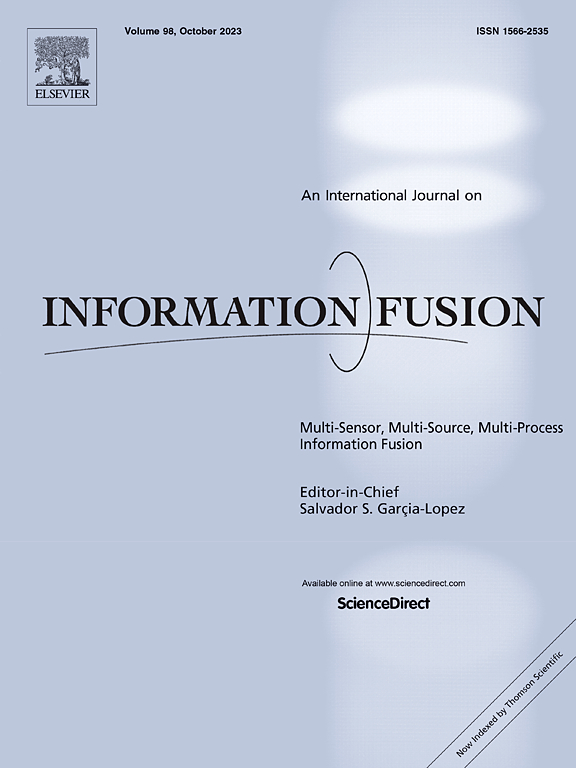无所遁形:对跨模态人再认同的暗示性线索引导
IF 14.7
1区 计算机科学
Q1 COMPUTER SCIENCE, ARTIFICIAL INTELLIGENCE
引用次数: 0
摘要
犯罪活动经常在夜间进行,以避免引起注意,这严重挑战了传统的再识别系统。近年来,可见光-红外人物再识别(VI-ReID)技术在低光场景下的广泛应用备受关注,该技术旨在跨越红外图像(夜间)和可见光图像(白天)固有的模态差距来匹配行人。以往基于深度学习的方法主要通过跨模态翻译或学习模态共享表征来弥补模态差距。然而,前者不可避免地破坏了原始模态信息,而后者忽略了交叉光谱特征之间的细粒度内在度量关系。在本文中,我们提出了一个包含表征学习和特征重构子网络的提示线索重构框架。在模态共享领域进行表征学习,我们提出了局部交叉对齐(LCA)损失来进一步优化跨模态聚类组件和中心之间的度量,探索细粒度的模态一致表征。在特征重构网络中,我们将红外和可见模态特征解耦,并引入重构编码器来学习与身份相关的提示线索,增强了跨模态学习的可控性。在SYSU-MM01和RegDB数据集上的大量实验表明,我们的SCR是一种新的最先进的方法。其中,在RegDB数据集上,SCR的Rank-1和Rank-10准确率分别为97.9%和100%左右。我们有趣的研究强调了暗示性线索在VI-ReID中的作用,我们的代码可以在https://github.com/ISCLab-Bistu/VI-ReID上获得。本文章由计算机程序翻译,如有差异,请以英文原文为准。
No escape: Towards suggestive clues guidance for cross-modality person re-identification
Criminal activities are frequently committed at night to avoid attention, which seriously challenges traditional re-identification (ReID) systems. Recently, visible–infrared person re-identification (VI-ReID) has been in the spotlight for wide applications in low-light scenes, aiming to match pedestrians across the inherent modality gap between infrared images (for night) and visible images (for daytime). Previous deep learning-based methods mainly bridge the modality gap either by cross-modality translation or learning modality-shared representation. However, the former inevitably damages the original modality information, while the latter ignores fine-grained intrinsic metric relationships between cross-spectral features. In this paper, we propose a suggestive-clues reconfiguration (SCR) framework, which includes representation learning and feature reconfiguration sub-networks. The representation learning is pursued in modality-shared domain, in which we suggest a local cross-alignment (LCA) loss to further optimize the metric between cross-modality clustering components and centers, exploring fine-grained modality-consistent representations. In the feature reconfiguration network, we decouple infrared and visible modality features and introduce reconfiguration encoder to learn identity-related suggestive clues, enhancing the controllability of cross-modality learning. Extensive experiments on SYSU-MM01 and RegDB datasets demonstrate that our SCR is a new state-of-the-art method. Specifically, the Rank-1 and Rank-10 accuracy of SCR are 97.9% and about 100% on the RegDB dataset. Our interesting research highlights the role of suggestive clues in VI-ReID, and our code can be obtained at: https://github.com/ISCLab-Bistu/VI-ReID.
求助全文
通过发布文献求助,成功后即可免费获取论文全文。
去求助
来源期刊

Information Fusion
工程技术-计算机:理论方法
CiteScore
33.20
自引率
4.30%
发文量
161
审稿时长
7.9 months
期刊介绍:
Information Fusion serves as a central platform for showcasing advancements in multi-sensor, multi-source, multi-process information fusion, fostering collaboration among diverse disciplines driving its progress. It is the leading outlet for sharing research and development in this field, focusing on architectures, algorithms, and applications. Papers dealing with fundamental theoretical analyses as well as those demonstrating their application to real-world problems will be welcome.
 求助内容:
求助内容: 应助结果提醒方式:
应助结果提醒方式:


